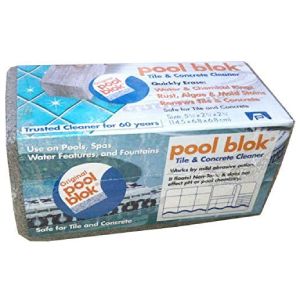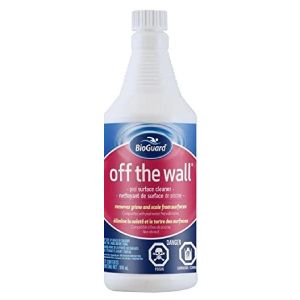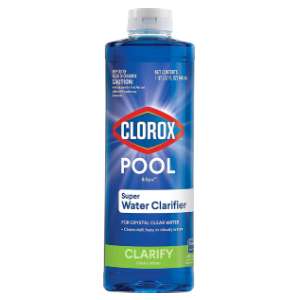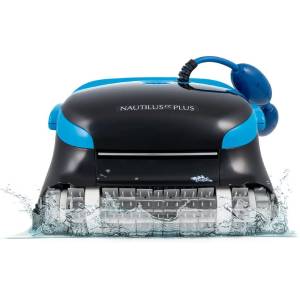- Salt Water Pool and Spa
- Salt Water Pool Maintenance
- Pool Tile Cleaner
Pool Tile Cleaner
A good pool tile cleaner will save you time and a lot of headaches when it comes to removing stubborn calcium, lime and hard water stains that can form over time along the water line. It can be a daunting task to get your pool finish looking how it did when it was new but it's possible with a bit of elbow grease and the right cleaning products. We've put together a step by step guide along with helpful tips and advice to get your tile looking brand new.

If you have stains around your pool the best way to deal with them is to prevent them in the first place. A healthy and balanced pool should never develop stains so if you have excess staining or calcium buildup your best solution is to test your water and adjust if necessary. If you want more detailed information on proper balancing of chemicals be sure to read our pool maintenance page that has a lot of useful information.
Pool Tile Cleaning Step by Step
The best time to clean your pool tile is in the spring before your pool opening chemical balancing. If you have stains that seem impossible to get off you will need to drain your pool water and it might be unavoidable to get some of the cleaner in your water. There are biodegradable cleaners available but they can still alter your pool chemistry which you will want to avoid during the swimming season to avoid costly and time consuming balancing.
You're at the point where you've got tired of looking at the stains on your pool tile and you're determined to do something about it. The calcium, lime or hard water deposits on your tile will be hard to remove and take some work so it's a good idea to be prepared for a full day or more to get this done. The stains took months or years to develop and it's going to take some time to get them off. Learn how a quick LSI calculation can help prevent scaling.
1. Purchase Necessary Cleaning Supplies
The first thing you should do is purchase a pumice stone, scale remover or all purpose cleaner. If you are cleaning only tile we recommend a good pumice stone that doesn't claim or need to be safe for vinyl or porcelain. The goal is to use the coarsest material possible that won't damage or scratch your tile. If you plan on using the stone on vinyl, porcelain or acrylic find one that is safe for those surfaces.
It seems like every pool company out there has it's own brand of pool tile cleaner and each claims they are better than the other. This is where it can get confusing but the bottom line is that they are all acid based and all do pretty much the same job. The only main difference you will find is the thickness of the liquid. If you prefer using a liquid or a gel you should be able to find both.
Pool Blok Pumice Stone for Cleaning Pool Tiles and ConcreteIf you click on this link and make a purchase, we may earn a commission. |
2. Lower Water Line
The next step will be to drain your pool approximately 4 to 6 inches below the stain line. If you are cleaning your tile during pool opening this shouldn't be necessary. Ideally you want to prevent as much of the cleaner and residue from ending up in your pool water. This can be difficult but once you get started you will develop a method that works depending on how stubborn the stains are. If you end up with cloudy pool water from cleaner residue you may be forced to use a flocculant but that should get your pool clean nicely.
3. Pool Tile Cleaner Application
The application of the pool tile cleaner solution is where things will get a bit dirty and where the elbow grease becomes necessary. You will most likely have to lay down on your pool deck or if you are more adventurous you can do it from in your pool. You should wear appropriate clothing so you don't damage your favourite pair of shorts.
The goal is to apply the liquid or gel with a brush or rag and let it sit for about 15 minutes or whatever is recommended by the manufacturer. Start out with a little bit of cleaner just to get an idea of how much it runs down the side of your tile. The goal is to apply a layer of cleaner to the stains without it ending up in the water. Work in sections starting with 6-10 feet or whatever you can clean during the 15 minute setting time window.
BioGuard Pool Wall Surface CleanerRemoves scale and grime from pool wall surfaces including tile, vinyl and concrete finishes. Non-abrasive formula. If you click on this link and make a purchase, we may earn a commission. |
4. Scrub with Pumice Stone
After the pool tile cleaner has had a chance to break down the stain it's time to give it a good scrub. You will need a bucket of clean water and an old rag so you can remove the excess cleaning solution. You might notice that the stain isn't coming off completely and decide to get as much off as possible and come back and reapply solution for a second round of cleaning. The amount of scrubbing and number of applications required will depend how difficult the stain is to remove which is usually correlated with how long it's been building up.
Pool Tile Cleaner Tips and Prevention
Hopefully you have worked through the above steps and are left with sparkling clean tile but if you are still unable to removed the stains and buildup there are a few options that you might want to consider. The absolute best way to deal with stains is to prevent them in the first place but if it's too late you may need to hire a professional pool cleaner or a company that specializes in pool tile cleaning.
Keep Pool Chemistry Balanced
The best way to never have to deal with stained tile is to keep you pool chemistry properly balanced. Pay special attention to calcium hardness, pH and alkalinity which can be checked quickly with a digital pool test kit. As you gain a handle on your pools chemistry you may need the help of other products designed specifically to prevent stains and buildup of calcium and other grime. A quality pool water clarifier will keep your pool crystal clear and prevent scum along the water line of your pool.
Clorox Pool & Spa Super Water Clarifier 32ozCombines small particles into large ones for easy filter removal. If you click on this link and make a purchase, we may earn a commission. |
Maintain a Clean Pool
A properly maintained pool with balanced water chemicals and pool hardware that's running smoothly will ensure a healthy pool. The pool filter is designed to keep both large and small particulate out of the pool and when it becomes compromised due to clogging or inadequate pump pressure you can run into problems. Any debris that isn't filtered out of the water can end up being deposited onto the pool wall over time. This constant accumulation can sneak up on pool owners and result in a stubborn mess that needs to be cleaned.
When it comes to pool cleanliness the last line of defence is a pool vacuum cleaner. There are countless options when it comes to pool vacuums but arguably the best option is one that operates independent of the pool system. While pressure or suction side cleaners will utilize the pump pressure within a system, a robotic pool cleaner will use its own onboard power supplied through its own electrical power. In the event that the pool system isn't running up to speed, an independently powered pool cleaner will be a final defence against grime build up.
A pool vacuum cleaner that climbs pool walls is one of the best ways to prevent pool water line scum buildup.
Dolphin Nautilus CC Plus Robotic Pool Vacuum CleanerRobot pool cleaner with wall climbing capability. If you click on this link and make a purchase, we may earn a commission. |
Bead Blasting
If your build up is so stubborn that you can't remove it with a pumice stone and cleaner or you want to hire a local pool company to do the dirty work you should consider bead blasting. This technique uses high pressure air similar to sand blasting that will break away calcium, lime or hard water stains that can't be removed with a pumice stone. If you suspect your pool chemistry was to blame for the stains be sure to close your pool properly and monitor your chemicals so you can prevent future problems.
Disclaimer
Please use all appropriate and proper safety precautions when attempting projects on this website. All projects are attempted at the reader's own risk.
Salt Water Pool and Spa™ participates in the Amazon Services LLC Associates Program, as an Amazon Associate we may earn a commission from qualifying purchases.



